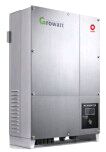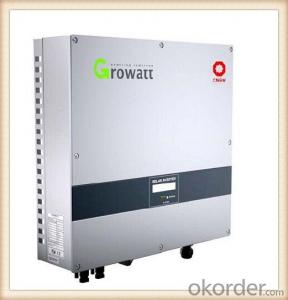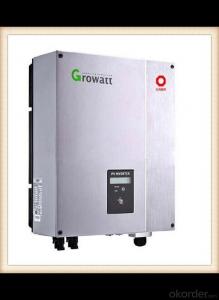Enphase Compatible CNBM-10000UE Grid-Tie Solar Inverter with Energy Storage Hybrid Solar Inverter
- Loading Port:
- China main port
- Payment Terms:
- TT OR LC
- Min Order Qty:
- 10000 watt
- Supply Capability:
- 100000 watt/month
OKorder Service Pledge
OKorder Financial Service
You Might Also Like
Introduction
CNBM-10000UE
CNBM-12000UE
CNBM-18000UE
CNBM-20000UE
Maximum efficiency of 97.9% and wide
input voltage range
Wide MPPT voltage
Internal DC switch
Transformerless GT topology
Compact design
MTL – String
Multi-MPPT
Certificate: CE, VDE 0126-1-1,
DK5940, G83/1-1, G59/2, RD1663,
EN50438, VDE-AR-N4105, CEI-021,
IEC-62109, ENEL-Guide, UL1741,
UL1998, IEEE1547, CSA
Warranty: 5/10 years
Features
Maximum efficiency of 97.9% and wide input voltage range
Internal DC switch
MTL-String
Bluetooth/RF technology /wifi
Transformerless GT topology
5 years warranty(10years as optional)
Images
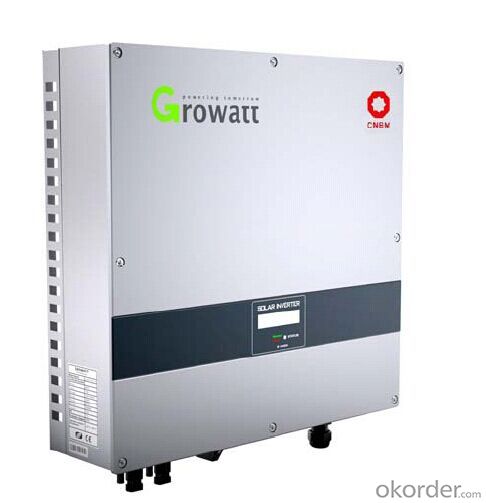
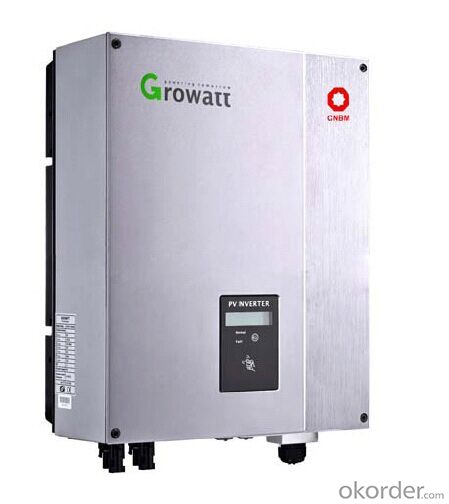
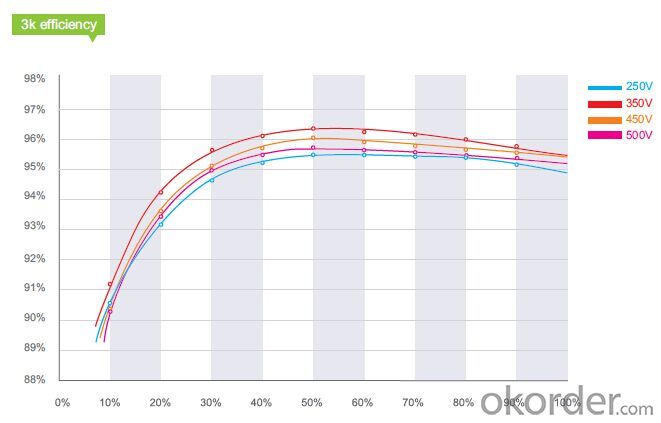
Sepecification

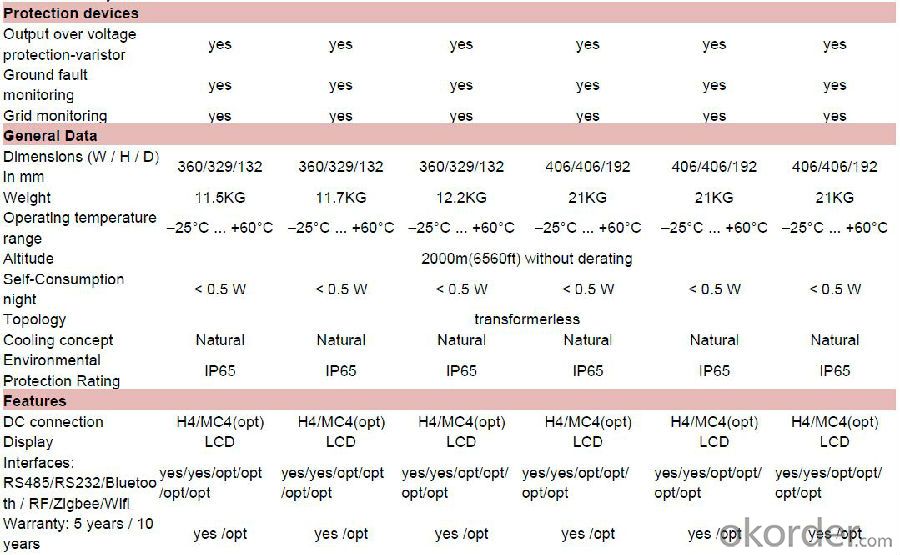
FAQ
Q1: How to choose a right inverter?
A1:Tell us your demand, then our sales will recommend a suitable inverter to you.
Q2: What's the different between inverter and solar inverter?
A2: Inverter is only accept AC input, but solar inverter not only accept AC input but also can connect with solar panel to accept PV input, it more save power.
Q3: How about the delivery time?
A3: 7 days for sample; 25 days for bulk order.
Q4: What is the warranty of inverter?
A4: 5/10 years warranty on CNBM-Solar product.
Q5: How to solve the technical problem?
A5: 24 hours after-service consultancy just for you and to make your problem to solve easily.
- Q: How does the power factor affect the performance of a solar inverter?
- The power factor affects the performance of a solar inverter by influencing its efficiency and capacity to convert DC power from solar panels into AC power. A low power factor can result in increased losses and reduced efficiency, leading to lower overall performance. On the other hand, a high power factor ensures efficient power conversion, minimizing losses, and optimizing the inverter's performance.
- Q: How does a solar inverter handle voltage transients?
- A solar inverter handles voltage transients by regulating and stabilizing the incoming DC voltage from the solar panels, and converting it into a steady AC voltage suitable for use in the electrical grid or for powering appliances. It uses various electronic components and control algorithms to monitor and adjust the voltage levels, ensuring that any sudden changes or fluctuations in the input voltage are smoothed out and the output remains consistent and within acceptable limits.
- Q: Can a solar inverter be used off-grid?
- Yes, a solar inverter can be used off-grid. In fact, off-grid solar systems often require a solar inverter to convert the DC power generated by solar panels into AC power that can be used to power appliances and devices.
- Q: How do you choose the right brand of solar inverter?
- When choosing the right brand of solar inverter, it is important to consider factors such as reliability, efficiency, warranty, and compatibility with your specific solar panel system. Researching customer reviews, comparing specifications and features, and consulting with solar professionals can help in making an informed decision.
- Q: Can a solar inverter be used in low light conditions?
- Yes, solar inverters can still be used in low light conditions. However, the efficiency of the solar inverter may be reduced as it relies on sunlight to convert solar energy into usable electricity.
- Q: What are the different types of solar inverters available?
- There are several types of solar inverters available, including string inverters, microinverters, and power optimizers. String inverters are the most common and are installed at a central location, converting the DC power generated by multiple solar panels into AC power. Microinverters, on the other hand, are installed on each individual solar panel, converting the DC power to AC power at the panel level. Power optimizers are similar to microinverters but work in conjunction with a string inverter, optimizing the power output of each panel before it reaches the inverter. Each type of inverter has its own advantages and suitability based on the specific solar installation requirements.
- Q: Can a solar inverter be used in a commercial or industrial setting?
- Yes, a solar inverter can be used in a commercial or industrial setting. In fact, they are commonly used in these settings to convert the direct current (DC) electricity generated by solar panels into alternating current (AC) electricity that is suitable for use in commercial or industrial buildings. Solar inverters are designed to handle larger electricity loads and are capable of efficiently powering various electrical equipment and machinery in such settings.
- Q: What is the lifespan of a solar inverter?
- The lifespan of a solar inverter typically ranges from 10 to 15 years, depending on various factors such as the quality of the inverter, proper maintenance, and operating conditions.
- Q: How do you maintain a solar inverter?
- To maintain a solar inverter, regular cleaning of dust and debris is essential to ensure efficient operation. Additionally, monitoring the inverter's performance and checking for any abnormal readings or error messages is important. It is also recommended to inspect the wiring connections for any loose or damaged parts and to keep the inverter's ventilation system clear from obstructions. Regular servicing by a professional technician is recommended to identify and address any potential issues before they become major problems.
- Q: What are the main components of a solar inverter system?
- The main components of a solar inverter system include the solar panels, the inverter itself, and various electrical components. Solar panels are the primary component of a solar inverter system. These panels are made up of photovoltaic cells that convert sunlight into direct current (DC) electricity. They are typically installed on rooftops or in open areas to maximize exposure to sunlight. The inverter is another crucial component of the system. Its main function is to convert the DC electricity produced by the solar panels into alternating current (AC) electricity, which is the type of electricity used in most homes and businesses. Inverters also regulate the flow of electricity, ensuring it matches the voltage and frequency of the utility grid. Other electrical components are also present in a solar inverter system. These may include wiring, switches, fuses, and circuit breakers, which help to connect the solar panels, inverter, and other equipment to the electrical grid. Additionally, monitoring systems and data loggers are often included to track the performance of the system and provide valuable information on energy production. Finally, a solar inverter system may also include a battery storage system. This allows excess electricity generated by the solar panels to be stored for later use, such as during periods of low sunlight or during power outages. Battery storage systems are becoming increasingly popular as they provide greater energy independence and the ability to utilize solar energy even when the sun is not shining. Overall, the main components of a solar inverter system include solar panels, the inverter, electrical components, and potentially a battery storage system. Each component plays a vital role in harnessing solar energy and converting it into usable electricity for homes and businesses.
Send your message to us
Enphase Compatible CNBM-10000UE Grid-Tie Solar Inverter with Energy Storage Hybrid Solar Inverter
- Loading Port:
- China main port
- Payment Terms:
- TT OR LC
- Min Order Qty:
- 10000 watt
- Supply Capability:
- 100000 watt/month
OKorder Service Pledge
OKorder Financial Service
Similar products
Hot products
Hot Searches
Related keywords



